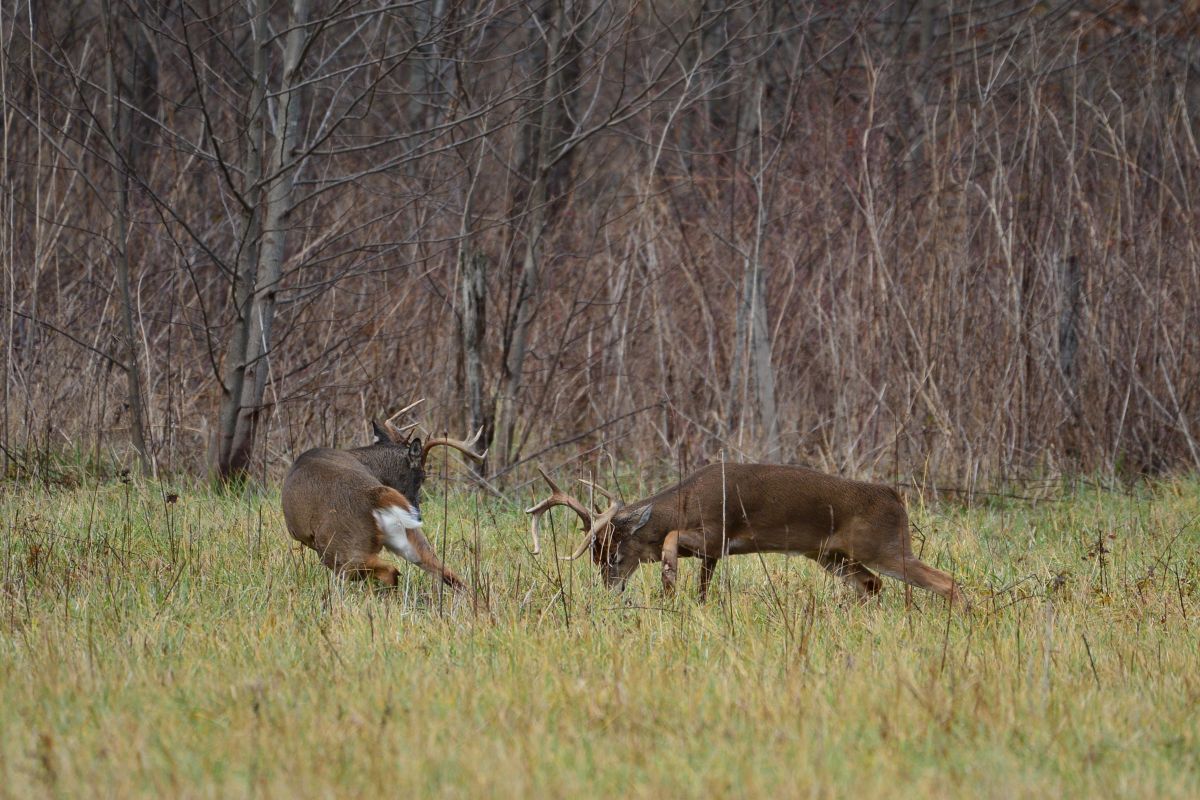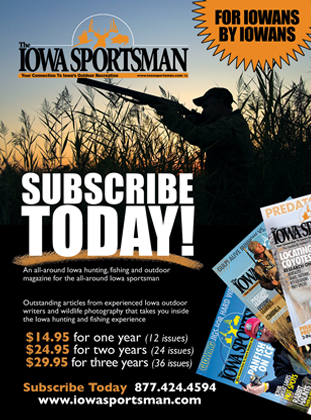The Whitetail Rut in Iowa: Whitetails365

The Whitetail Rut in Iowa: A Week-by-Week Bowhunter’s Guide
The timber was still dark when I slipped into my stand that November morning, the frost crunching under my boots. The kind of morning where you can feel that it’s going to be a good hunt. The woods were electric as the sun came up. Right after first light, it happened. A lone doe broke through the creek bottom, nose low, tail twitching. She wasn’t feeding—she was moving, head on a swivel, glancing over her shoulder every few steps. The way she acted told me everything I needed to know: she was hot. The rut had officially flipped the switch.
Moments later, the timber behind her came alive. A thick-bodied 10-pointer materialized from the cedars. He dogged her hard, pushing her through the open timber and across the ridge, grunting along the way and covering a lot of ground. He wasn’t alone for long. Another buck—taller tines, heavier frame—crashed in from the east, ears pinned back and posturing up, ready to clash antlers.
At one point, the hot doe swung within 20 yards of my tree. I knew I’d have my chance at at a shot. The biggest buck cut in towards her. It was the kind of rut-crazed moment bowhunters dream about—the woods erupting with life, the air buzzing with adrenaline, and time slowing down to a razor’s edge. At 25 yards, my arrow found its mark, and that’s a hunt I’ll never forget.
Plan Your Rutcation
For bowhunters, November isn’t just another month—it’s the month. The whitetail rut picks up filled with, unpredictability, and adrenaline. Though the rut can vary year to year due to weather patterns, disease pressure, and local activity, one factor remains constant: whitetails are photoperiodic animals. Their breeding cycle is triggered primarily by changing daylight hours, which means we can anticipate key phases with surprising consistency.
Research from the Iowa DNR and multiple private studies analyzing fetal aging data show that the majority of does are bred within the first three weeks of November. By measuring fetal crown–rump lengths from harvested does and backdating conception, biologists have built a reliable timeline of breeding peaks across the state. That doesn’t mean every rut looks the same—but understanding these trends can help you plan your “rutcation” wisely.
Two truths hold every season. Cold weather amplifies movement. A hard frost or early snow can accelerate doe readiness and increase daylight activity. Cold fronts consistently spark a bump in buck movement. Secondly, a hot doe changes everything. When a single doe hits estrus, she can ignite the entire timber. Bucks from every corner of the section show up to dog, posture, and compete for her.
Here’s a breakdown of what to expect through the four critical weeks of November in Iowa, one of the best bowhunting states in the country.
Week 1: Cruising Begins
Early November marks the start of serious daylight movement. Bucks are amped up and on the move, cruising ridges and creek bottoms with their noses down, checking scrapes and seeking that first doe approaching estrus. You’ll often catch mature bucks slipping out of their bedding earlier and staying on their feet longer. At this time, they’re not quite moving all day, but this is prime time to focus on doe concentration areas. You might find success on food plots, bedding pockets, and travel corridors. Research shows that pre-estrus activity surges during this phase, as bucks expand their range to find receptive does. Set up along active scrape lines or travel funnels and pay attention to incoming cold fronts, which can trigger intense bursts of movement. Hunt timber edges and scrapes during cool, high-pressure days. If you know a farm with a strong doe population, that’s where the bucks will be checking.
Week 2: Peak Seeking and Chasing
The latter part of week 1 into week 2 tend to be about my favorite times to hunt. Iowa DNR data shows the rut’s bell curve begins to crest between the second and third weeks of November, meaning more does are entering estrus daily, and this causes the bucks to be on the move. Bucks are covering serious ground, checking every doe they encounter and chasing hard when they find one that’s ready.
This is the week of chaos in the timber. Bucks are grunting, growling, fighting, and running off other bucks. Calling and scent tactics are especially effective now. Grunts, rattling, and estrus scents can pull in curious or aggressive bucks. Focus your sits on intersections of well-traveled deer paths or funnels. At this point, bucks are moving during all parts of the day. Midday movement often spikes as bucks stay on their feet all day searching for hot does.
Week 3: Peak Breeding
By the third week, the rut is in full swing. Several does are in estrus, and breeding activity is in full swing. As bucks breed, they go an search for new does and when they find a prospect, they’ll follow her around. This can be a good opportunity to hunt travel corridors, as bucks will be covering a lot of ground quickly if they’re looking for a new doe. You’ll also notice bucks are often “locked down” with receptive does, pushing them into secluded areas like draws, fence lines, or field edges to hide them from other bucks.
Bucks are still moving throughout the day, this is the time for long, all-day sits. Bringing lunch to the stand can pay off; research and hunter observations show late-morning movement can be excellent. You may see a dominant buck guarding a single doe, but other mature bucks are still covering ground looking for the next opportunity.
If you’re still hunting, don’t give up. Some big bucks are still killed during this time frame every year. Stay patient. Focus on travel corridors near bedding cover, and keep an eye out for locked-down pairs.
Week 4: Rut Tapers, Feeding Returns
The final week of November brings a noticeable shift. Breeding activity slows as the majority of does have been bred. Bucks that spent the past three weeks burning calories and fighting are worn down—studies show they can lose 20–25% of their body weight during the rut. They become more cautious and start to focus on regaining energy, especially as winter approaches. You bet they’re still checking does on the food plots, but they’ve been fighting, and running, and need to replenish calories.
However, not all does cycle at once. Younger or late-cycling does can still come into heat, sparking isolated bursts of rutting behavior. Rember that the rut is a bell curve, and some does came into heat during late October. If they weren’t bred, they will cycle back into heat 28 days later. There is still a lot of promise and activity around this last week. A lot of bowhunters get burnt out and quit if they haven’t filled their tag, but there is a lot of opportunity to see a mature bruiser at this time. A late estrus doe can bring a mature buck back into daylight. This is also an excellent time to hunt food sources again, as deer shift back toward feeding patterns. Target food plots or ag fields during evening hunts.
Final Thoughts
The Iowa rut is a roller coaster of unpredictability and pattern. It matters most what is going on in your area that you’re hunting. While exact timing can shift slightly each year, understanding photoperiod, fetal aging research, and how weather plays into movement gives bowhunters a strategic edge. Anything can happen during November—and often, it happens fast.
Scouting remains crucial. If you spot a buck dogging a doe one day, there’s a good chance they’ll still be in that general area the next day. Adapt to what you’re seeing on the ground, keep the wind in your favor, and maximize your time afield. The rut only comes once a year. Plan your hunts and vacation, and enjoy every second of it. November only comes once a year.
By Aaron McKinney
November 2025
Here is last month’s issue of Whitetails 365
Or if you are looking for the digital version of this months issue here it is below
Looking for the Cattle/Dairy side of things

